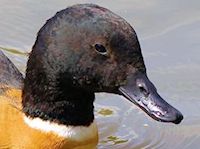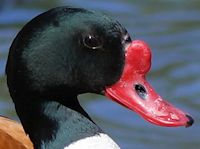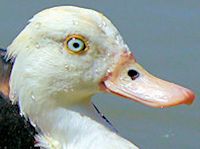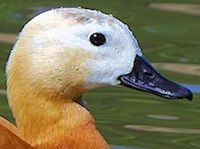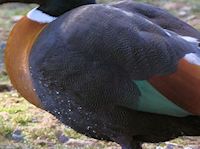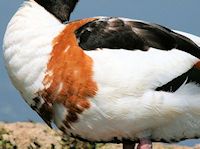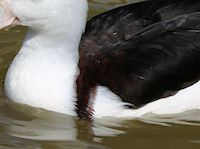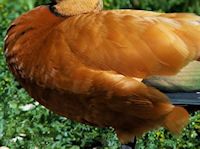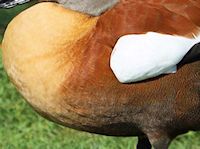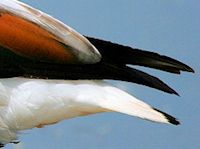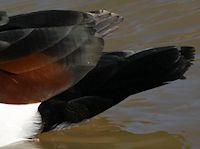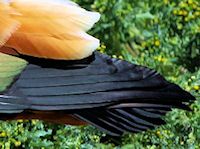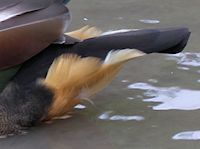Australian Shelduck.
A very dark Green head, Chestnut coloured breast, a White neck collar, dark Blackish body, Black primaries and Green secondaries. It has a Grey bill and Grey legs and feet.
Common Shelduck.
A dark Green head and neck, Red bill and Knob, White breast, with a Brown band round the breast
and mantle. The back and belly is White, the wings are White with Black primary feathers and the legs
and feet are Pink.
Radjah Shelduck.
White plumage with metallic Green on top of their wings, dark wing tips and a ‘collar’ around the breast.
The back and tail is Brown Black, the eyes are a striking White, the bill is light Pink and the legs and feet
are also Pink.
Ruddy Shelduck.
Orange Brown plumage with a lighter face and crown with a Black collar around the neck just above the
breast. The rump and tail are Black and the wings are White with Black flight feathers. The bill is Black and
the legs and feet are also Black.
South African Shelduck.
A Grey head and upper neck, a Black bill, a Buff lower neck and breast. The body is Chestnut Brown with
Black with White and Green wings. The legs and feet are dark Grey.
Now that we have identified the Shelducks, where can we find them at WWT Slimbridge?
They can be found in the following Zones: -
Australian Shelduck. -
Australia Zone.
Common Shelduck. -
Tundra Zone.
Radjah Shelduck. -
Australia Zone.
Ruddy Shelduck. -
Asia Zone.
South African Shelduck. -
Flamingo Lagoon.
Did You Know?
 | The Australian Shelduck is the largest duck in Australia. |
|
 | Shelducks nest in tree hollows, old animal burrows and cavities. |
|
 | Shelduck young are kept in 'nursery waters' where thay are looked after by other adult shelducks. |
|
 | Ruddy Shelducks are considered sacred by Buddhists because their colour resembles the robes
worn by monks. |
Related Links:-
Crane Identification
Dabbling Duck Identification
Diving Duck Identification
Flamingo Identification
Geese Identification
Sea Duck Identification
Shelduck Identification
Shoveler Identification
Swan Identification
Whistling Duck Identification
You can help to protect wetland habitats in the UK and around the World by becoming a member of the WWT,
visit official WWT site for details.

